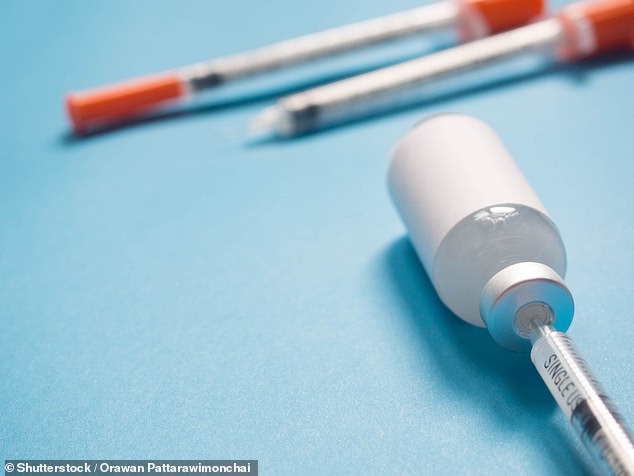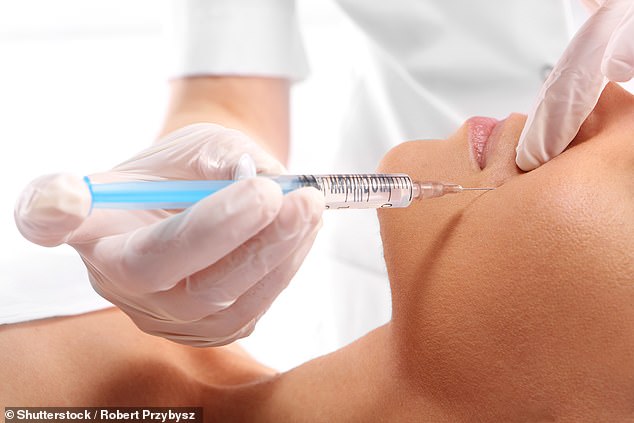In the weeks before D-Day – June 6, 1944 – when more than 150,000 Allied troops stormed Normandy’s beaches, the War Cabinet had been locked in talks over a terrifying new threat. The fear – unfounded, as it turned out – was that the Nazis were preparing to unleash biological bombs containing powdered botulinum toxin on the invading armies.
This micro-fine dust, once it enters the body through the eyes, nose or throat, travels deep into the nerves and muscles. The paralysis it causes starts at the head and moves down the body, affecting the limbs and, eventually, the lungs.
Victims at first suffer fatigue and vertigo. Grotesque drooping of the face and slurred speech follow. The eyes may roll uncontrollably. Finally, breathing becomes laboured and, without mechanical ventilation, suffocation is inevitable. It is a horrible way to die – and an offshore wind could have carried it out to the thousands of landing craft, causing devastation well beyond the 4,400 confirmed dead that day.
Today, as hard as it might be to believe, that biological weapon of war is engaged in a very different battle – the one being fought against ageing. For botulinum toxin is, incongruously, the main ingredient in Botox injections, now a multi-billion-pound international industry which aims to terminate armies of frown lines and wrinkles.
And I should know. Although I’d never say it myself, I’ve been called the ‘High Priestess of Plastic Surgery’ after 25 years of reporting on the industry for Conde Nast’s flagship beauty magazine, Allure. But more than that, I have Botox myself – and I don’t fear it. It’s a very safe drug.

Devotee: Joan Kron (pictured above), who started Botox at 66. She has been called the ‘High Priestess of Plastic Surgery’ after 25 years of reporting on the industry for Conde Nast’s flagship beauty magazine, Allure
I started having the jabs when I was 66 – 27 years ago. Then, in 1994, it was new and still unapproved for cosmetic uses. It would be almost ten years before this would happen, but I’d heard about it and what it could do – everyone in ‘the industry’ had.
So when my dermatologist suggested I try it, off-label, I considered it part of my job. Botox softened a crease in my forehead that had troubled me despite having had a lower face lift, and improved my eye crinkles. I was hooked. I still have tune-ups twice a year and, at 93, I think it’s working for me.
And I’m far from alone. In 2019 there were 6.2 million Botox appointments carried out across the world, around 100,000 of them in the UK. And that’s just for beauty. The drug’s ability to relax muscles means it can also be used medically, treating everything from migraines to spasticity, excess sweating and female incontinence.
Studies are looking at its effectiveness in prostate cancer, atrial fibrillation, depression, back pain, erectile dysfunction and other conditions.
Yet few people, even the doctors who dispense it, know anything about the origins of Botox, or the fact that the drug is intrinsically tied to the secretive history of biological warfare research.
Indeed, when President Nixon banned the offensive use of biological weapons in 1969, much of the information related to botulinum toxin was shredded. Now the story is set to be told in my forthcoming documentary, Weapon Of Beauty.
In the early 90s, Dr Arnold Klein – the late dermatologist to the stars, most notably Michael Jackson – had suggested I delve into the history of US military site Camp Detrick.
It was set up as a counterpart to the Manhattan Project, which was developing the atom bomb – to study all kinds of biological and chemical warfare. They never wanted to use these weapons, but to defend against them they had to understand them.
Among these weapons was anthrax, codename ‘N’, and botulinum toxin, dubbed ‘agent X’, the active ingredient in Botox. I was fascinated – and more so when an information officer at Detrick insisted the site had no link to botulinum production.

Deadly: Edward Schantz and his former assistant Eric Johnson in 1994 with a vial of undiluted botulinum toxin – enough for tens of thousands of lethal doses
In the course of making my film, in 2018 I also travelled Europe to visit three cosmetic toxin factories and ended the trip at Porton Down, the British military research site near Salisbury.
A civilian team at Porton Down, which was also involved in Second World War botulinum toxin research, created their own version of Botox, called Dysport. But to truly understand how this got from the secret labs of intelligence services into the syringes of cosmetic doctors, it’s important to start at the beginning. Clostridium botulinum is a harmless bacteria found in soil and sand. But in certain atmospheric conditions – warm, moist, low acidity and no oxygen, such as inside a sealed tin of vegetables or soup which has not been sterilised properly – it produces a potent poison, botulinum toxin.
BOTOX FACT
Injecting Botox into armpits or hands reduces excessive sweating by blocking the nerves responsible for activating their sweat glands.
Advertisement
In Germany in the early 1800s, an inquisitive doctor, Justinus Kerner, wondered what was killing and paralysing hundreds of his countrymen. Half of those who fell ill – with symptoms which included nausea, vomiting, diarrhoea, dilated pupils, double vision, muscle stiffness and difficulty swallowing – ended up dead.
He discovered the culprit: undercooked blood sausages, and specifically a bacteria which was subsequently named clostridium botulinum (from the Latin ‘botulus’, meaning sausage). The poison it produced caused a paralytic condition that was named botulism. It took them 100 years, but eventually scientists began looking at ways to use it for nefarious purposes.
It’s been hypothesised that botulinum toxin was used in the assassination of Holocaust-architect Reinhard Heydrich by Czech under-ground operatives in Prague in May 1942. A grenade – allegedly custom made at Porton Down and containing powdered botulinum toxin – missed the Nazi’s open-topped car, but he was wounded by splinters from the explosion. He died within a week, officially of sepsis, but with the distinctive symptoms of botulism, including paralysis and respiratory failure.
Fears that the Nazis planned to unleash botulinum toxin bombs came to nothing – the rumours were part of a misinformation campaign by German intelligence services, seeded in the British press. But inoculating troops against the toxin prior to D Day was discussed at the highest levels, before those plans were abandoned. It was even claimed by The New Yorker’s investigative journalist Seymour Hersh, that British, American and Canadian troops were given self-injector syringes filled with an anti-toxin to use on the Normandy beaches. And all of this was key in spurring the Allied forces in establishing a biowarfare defence programme.
Back then, Porton Down lacked the capacity to produce large quantities of the powdered botulinum toxin needed to fill bombs. But more importantly, it risked being bombed – and due to its location close to Salisbury, the fallout could kill civilians. So the British turned to Camp Detrick, formerly an abandoned airfield in Maryland, to produce and manufacture the poison as one of its first projects.

In 2019 there were 6.2 million Botox appointments carried out across the world, around 100,000 of them in the UK. And that’s just for beauty (file photo)
The work at Detrick was highly classified, carried out in a special containment lab disguised as an innocuous shack. It was nicknamed, by the scientists working there, the Black Maria, after the British police vans. Then the toxin was shipped to Britain to fill the bombs, which were never used and eventually destroyed.
But that wasn’t the end of it. The toxin was studied for years at Detrick, and working on the project was a young bacteriologist from Wisconsin named Edward Schantz.
He was perfecting a method of purifying botulinum toxin to understand its capabilities, and therefore be better able to defend against it. His research, however, led to something unexpected – when injected in a very diluted form, botulinum toxin could relax muscles in a small area of the body without proving lethal or permanent.
It works by temporarily blocking signals between the nerves and muscles. The chemical remains locally, and doesn’t enter the circulation, and the effect wears off in a matter on months.
In the late 60s, San Francisco ophthalmologist Alan Scott was looking for a non-surgical way to treat strabismus, a muscle condition that causes crossed eyes – and had heard through the scientific grapevine that someone at Detrick was working on an injectable compound that might do it.
He contacted Schantz, who gave him some botulinum toxin, advising him to use a tiny amount. It worked in monkeys, and when Scott eventually got permission to trial it in humans there was an added bonus. Trial participants ‘used to joke they were there to get the wrinkles out,’ Scott admitted in an email to me, almost ten years ago. But he didn’t consider it important.
His company, Oculinum, got approval from US regulators to use botulinum toxin to treat strabismus in December 1989. But the cost of producing the purified drug was more than Scott had expected. In 1991 he sold Oculinum, and 100mg of Schantz’s purified toxin, batch 79-11, for £6.5 million to a small California-based eyecare company, Allergan. They named it Botox. What Scott had failed to recognise, that the toxin also had significant cosmetic effects, was by then becoming clear to his colleagues.

When Botox was approved for cosmetic use in 2002, it was a hit – and a single spoonful of Schantz’s toxin, highly diluted, was enough to fill the first ten years of Allergan’s therapeutic and aesthetic orders (file photo)
One of them was Jean Carruthers, an eye specialist in Vancouver. In 1987 she was writing up the results of a study using botulinum toxin for blepharospasm – uncontrollable blinking – when a participant returned, asking for another shot. The toxin had solved the blinking issue, but it had also flattened a frown line in her forehead. The effect was wearing off – and she wanted more.
Jean’s receptionist, Cathy, had a deep vertical frown line between her eyebrows and she offered her a shot of the toxin – the first one ever administered specifically for this purpose. The line vanished. Intrigued, Jean’s dermatologist husband Alastair Carruthers suggested a cosmetic trial. Allergan had struck gold.
When Botox was approved for cosmetic use in 2002, it was a hit – and a single spoonful of Schantz’s toxin, highly diluted, was enough to fill the first ten years of Allergan’s therapeutic and aesthetic orders. It is so potent that ingesting one millionth of a gram of Botox is enough to cause lung paralysis and death. But dilute it sufficiently, and one billionth of a gram injected into muscle can safely smooth out wrinkles.
Plastic surgeons fretted that Botox shots would cut into their facelift business and film directors were certain it was destroying actors’ ability to show emotion. But Botox ultimately prompted frenzy among those determined to preserve the relaxed visage of youth and, for dermatologists, it was the pay day they had been waiting for. Botox, the most popular cosmetic surgical treatment in the world, has made many of them wealthy.
Today jabs are available at beauty spas and hairdressers. No one – certainly not President Roosevelt, who first green-lighted botulinum research – could have foreseen that. What I hope, and the reason for making the film, is that it can be taken seriously.
I’ve made it my career to give legitimacy to subjects often treated as fluffy. After all, the war against ageing is one we’ll be waging for a very long time to come.
Weapon of Beauty is being produced by Joan Kron’s Parvenu Ventures in partnership with The Documentary Group.
Source link : https://www.dailymail.co.uk/health/article-10027913/JOAN-KRON-Botox-began-biological-weapon-used-fight-migraines-pain.html











